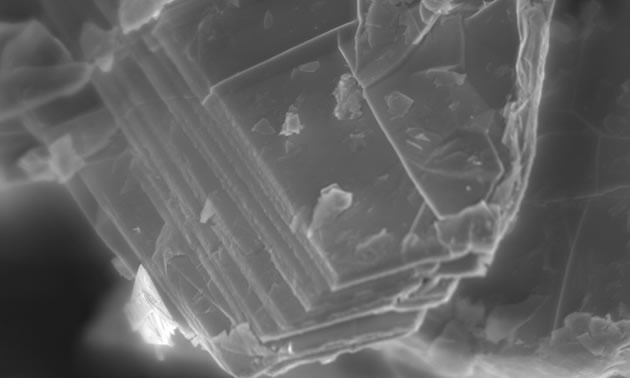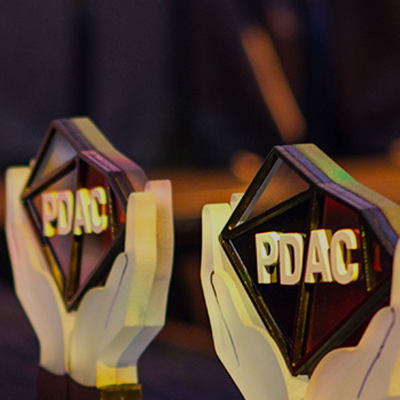A miracle metal
Graphite is considered a critical element in the emerging green economy

The La Loutre property is situated in the heart of graphite-rich Quebec. — Photo courtesy Lomiko Metals Inc.
A. Paul Gill is the CEO of Lomiko Metals Inc., a Surrey, B.C.-based, exploration-stage company. The company is engaged in the acquisition, exploration and development of resource properties that contain minerals for the new green economy.
Its La Loutre property consists of high-grade flake graphite in one large contiguous block of 42 mineral claims totalling 2,509 hectares. Located 117 kilometres northwest of Montreal, the project is situated in the heart of Quebec’s graphite area with neighbours like Northern Graphite, Nouveau Monde and Imerys Carbon and Graphite, which has the only operating graphite mine in North America.
Infrastructure is excellent as the La Loutre project is 1.5 hours from the international seaport of Montreal along a paved highway. They are ready to drill their second resource in a high-grade (10+ per cent Cg) deposit. The La Loutre graphite resource consists of 18.4 million tonnes of 3.19 per cent in the indicated category and 16.7 million tonnes at 3.75 per cent flake graphite inferred with a cut-off of 1.5 per cent at the Graphene-Battery Zone.
In 2018, Lomiko signed a deal to increase the ownership of the La Loutre Property to 100 per cent. Further, it was able to raise $1.5 million for development of the project and launched several technology initiatives that will be going to the public markets in 2019.
Lomiko plans to complete drilling at the refractory zone of the La Loutre Property to create a second resource, a complete metallurgy and a 3-D model of the property. By the end of 2019, a pre-economic assessment (PEA) will establish a book value for the project.
Graphite’s many uses
There are times when investments look odd on the surface but make a lot more sense once you perform due diligence. With debate circulating over the production of oil and pipelines in Canada, pencil lead might just be what we need to help move Canada to a green economy.
Graphite pencil lead is only one form of a very common substance—carbon. Coal, another form of carbon, shaped our modern Industrial Revolution, and the coal-bearing areas of the Ozark Mountains made America an Industrial giant in the early 20th century. Another form of carbon creates diamonds, one of the hardest and most beautiful gemstones in the world.
Graphite is best known as pencil lead, but it has an incredible array of new uses that make it a miracle material. A primary use for graphite is to create refractories, which are heat-resistant materials used in manufacturing steel and in moulds and as insulating bricks in steel foundries. In addition, graphite is useful as a dry lubricant in areas liquids can’t be used—heat sinks in outdoor and stadium lighting, vehicle brakes, and as an additive in manufacturing.

A magnified flake of graphite. The potential uses of graphite are many, including as anodes in the manufacture of lithium-ion batteries, the most prevalent power system for electric cars. — Photo courtesy Lomiko Metals Inc.
However, graphite’s primary use and the reason it is considered a critical element by both the European Union and America is its crucial role in the green economy.
It exceeds copper in the ability to handle electrical current, and to conduct and contain heat. Further, it is much easier to combine into 3-D printing materials—a bright future in additive manufacturing. However, the most exciting use is as an anode in a lithium-ion battery, the most prevalent power system for electric vehicles.
Electric vehicles will be 50 per cent of the cars on the road by 2040, predicts Bloomberg New Energy Finance. The current EV technology depends on the lithium-ion battery. There is 15 times more graphite than lithium in these batteries. Lithium has increased four-fold in price due to demand. The demand for graphite is now increasing as the price for battery-grade graphite materials has doubled in the last three years and is slated to move higher.
World supply of graphite
In 2012, China supplied 90 per cent of the world's graphite but that percentage has been dropping every year until, in 2018, the number was 70 per cent. More graphite is being consumed by the Chinese lithium-ion battery manufacturing boom led by e-bikes, EVs and cellular phones and tablets. Both the European Union and the United States have declared graphite a critical mineral, which indicates there is no economic alternative.
This is good news for graphite companies in Canada. Canada has a good reputation as a country that is able to supplant Chinese supply of graphite and provide secure supplies. Quebec is especially important due to the proximity to Eastern American industrial centres and Quebec’s long-term and stable approach to the mining industry.
Graphite prices have increased 100 per cent in the last three years to over $2,000/tonne. If this were the gold markets, investors would be dancing in the streets. However, in the battery materials space, we must see a multi-year, sustainable run to call it a bull market. This will likely occur, as it did in the lithium market, as demand outstrips supply. Speculative interest in the graphite market is already beginning to take off, and this should help attract major customers or partners to Lomiko’s La Loutre project.




